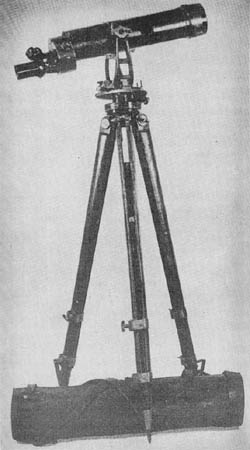 The Japanese multiple power observation telescope has three powers: 33X, 24X, and a third degree of magnification which has not been determined because of the absence of a third eyepiece in the instrument examined. Selection is made by rotating a dome-shaped holder in which the three eyepieces are mounted. This is somewhat similar to the turret head employed in motion picture cameras and to the selective eyepiece head of compound microscopes.
The Japanese multiple power observation telescope has three powers: 33X, 24X, and a third degree of magnification which has not been determined because of the absence of a third eyepiece in the instrument examined. Selection is made by rotating a dome-shaped holder in which the three eyepieces are mounted. This is somewhat similar to the turret head employed in motion picture cameras and to the selective eyepiece head of compound microscopes.
The objective is a compound lens with an air space between the crown and flint components. A modified porro prism is used for the erecting system. The reticle design used with the 24 power eyepiece is a simple cross. The 33 power eyepiece is not equipped with a reticle. No provision is made for an instrument light. An open line sight is provided for quick location of an object in the field of view.
The support which is made largely of machined brass castings has an upper and lower movement. The azimuth scale is graduated from 0 to 360 degrees in 1/2 degree steps; a vernier indicator allows readings of one minute to be made. Leveling is accomplished by adjusting the length of the tripod legs. The elevation arc is graduated in increments of 1/2 degrees to + and -30 degrees from 0. The tripod is of wood with brass fittings.
SPECIFICATIONS
| Length of telescopes | 24 ins. | |
| Weight of telescopes | 12 lbs., 8 ozs. | |
| Height of support | 11 1/2 ins. | |
| Distance between trunnions | 5 1/4 ins. | |
| Weight of support | 13 lbs., 4 ozs. | |
| Length of tripod | 38 1/4 ins. | |
| Length of tripod (legs extended) | 55 1/2 ins. | |
| Weight of telescope | 8 lbs., 8 ozs. |
Japanese: p. 177 (March 1, 1945)